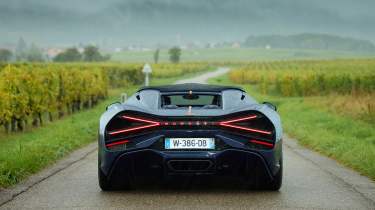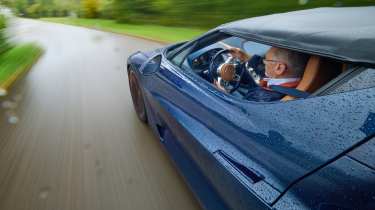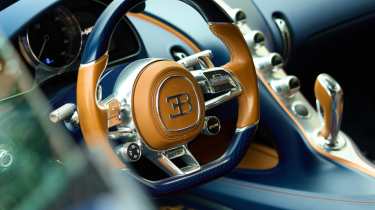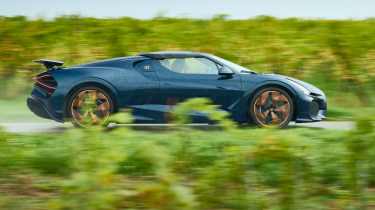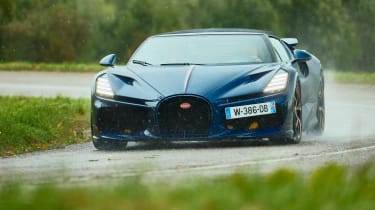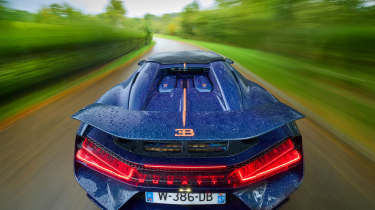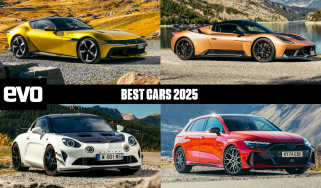Bugatti Mistral review – behind the wheel of the £5m W16 swansong
When you’re invited to drive the 1578bhp, 282mph, convertible Bugatti Mistral, the one thing you don’t need is rain. But when it’s the final outing for the legendary 8-litre, quad-turbo, W16 engine, you’d be mad not to
Imagine flying to Dubai to visit the Burj Khalifa, the tallest building in the world. You ride the elevators over half a kilometre skywards to the viewing platform on the 148th floor and step out only to find the view obscured by fog. That’s kind of how I feel just now. We’ve trekked to Gatwick, ‘enJoyed’ an easyJet flight to Basel and rocked up at the Bugatti factory in Molsheim, France, to drive the Mistral, officially the fastest open-top car in the world… and it’s absolutely chucking it down. We have just four hours with the car and if it doesn’t stop raining we won’t even get the roof off, let alone feel the full force of the W16 engine that powers it to a verified top speed of 282.1mph.
All 99 Mistrals were sold as soon as the car was announced, perhaps partly because it represents the end of an era, being the last Bugatti road car powered by the remarkable 8-litre, quad-turbo, W16 engine. All 99 will be delivered to customers by the end of 2026. They have to be because that’s when the W16’s homologation expires.
> The Bugatti Chiron’s successor will feature a hybrid V16, and it sounds incredible
More reviews
Group tests
- Lotus Emira Turbo SE v Alpine A110 GTS – two of the last surviving mid-engined sports cars
- Alpine A290 v Alpine A110 – how much DNA do they really share?
- Ariel Atom 4R v Caterham Seven ‘evo25’: power-to-weight heroes go head-to-head
- Ariel Atom 4 v Caterham Seven 310R v Lotus Elise Cup 250
- £200,000 supercar shoot-out: AMG v Aston Martin v Maserati v McLaren
- Audi Quattro, RS2 and RS3: five-cylinder icons head-to-head
- Who makes the best GT car? Aston Martin v Bentley v Maserati
- Caterham Super Seven 600 v Super Seven 2000
- Corvette Stingray v Porsche Cayman GTS v Audi R8 RWD
- GMA T.50 v McLaren F1 – has the best car in the world been dethroned by its successor?
In-depth reviews
- Abarth 600e 2025 review – Italy gives the Alpine A290 something to worry about
- Alpine A110 review – the sports car Lotus should be building
- Aston Martin Vantage 2025 review – a thrilling Mercedes-AMG GT and 911 Turbo S alternative
- Used Audi RS2 (1994) review – an unsung '90s hero you can own for £40k
- Audi R8 (2015 - 2024) review – the ultimate soft-focus supercar
Long term tests
- Abarth 695C Turismo Fast Fleet test – living with the charming Italian hatch
- Alfa Romeo Giulia Veloce long term test – can Italy beat Germany?
- Alpina B10: Alpina B10: end of term report
- Aston Martin Vantage (2006) Fast Fleet test – living with a £30k V8 Aston
- Caterham Seven evo25 Fast Fleet test – living with a track car for the road
- Caterham Seven evo Edition revealed – bespoke 420R joins the Fast Fleet
- Cupra Leon 300 Fast Fleet test – living with Spain's 300bhp hot hatch
- Cupra Ateca VZN Fast Fleet test – four months with Cupra's hot crossover
- Cupra Leon Estate 310 4Drive Fast Fleet test – living with the 306bhp hot estate
- Ford Mustang GT
Review
- New Bentley Batur 2023 review – can it possibly be worth £1.65m?
- 2023 Chevrolet Corvette C8 Z06 review – the American 911 GT3?
- BBR Supercharged Mazda MX-5 (ND) 2023 review – tuned 250bhp roadster driven
- MG4 Trophy 2023 review
Reviews
- Abarth 695 75 Anniversario edition 2024 review – a fitting send-off for Abarth’s hot supermini?
- Abarth 500e 2023 review
- AC Cobra 378 Superblower MkIV 2021 review – another V8 Cobra, but with a GM heart this time
- Acura Integra Type S 2024 review – a Honda Civic Type R with added restraint
- Alfa Romeo Giulia review – get one while you still can
- Alfa Romeo 33 Stradale 2025 review – a rare Italian jewel beyond compare
- Alfa Romeo SZ: history, review and specs of an icon
Weather apart, there’s a satisfying symmetry to my visit. I was last here on a warm afternoon 20 years ago, returning an early example of the Veyron, the first car powered by the W16. It’s been quite a journey since. The W16 – effectively two narrow-angle, four-litre V8s spliced to a common crank – arrived with an astonishing 1001 PS (987bhp) and departs, two decades later, with an equally astonishing 1600 PS, or 1578bhp in olde money.
For various reasons I’ve not driven any of the models between Veyron and Mistral, not the Veyron Super Sport or the Grand Sport Vitesse or any Chiron (1500 PS, 1479bhp). However, as chance would have it, I very recently drove an original Veyron again, so by the end of the day I’ll have recent experience of the two cars that bookend the W16 era.
Sitting there in the rain beside the Bugatti chateau, its dramatic bodywork beaded with raindrops, the Mistral looks a million dollars, as well it should because it actually costs closer to $6m, or £5m. We have a fondness for open-top cars in the UK in spite of rather than because of our climate, but I imagine that most Mistrals will be going to customers with homes in consistently warmer and drier climes. I say this because while the finish of the Mistral is exquisite, its shut lines perfect, its rich blue paint flawless, the roof is rather inelegant and a bit lumpy. It’s recommended only for speeds up to 100mph, which I reckon makes it the equivalent of a space-saver spare: intended for use only in an emergency.
I confess that I struggle to see the point of open-top supercars, and one that does almost 300mph sounds like a device designed to wrench the hair from your head and pluck your eyebrows. Not so, according to a text from Bugatti ‘Pilote Officiel’ and friend of evo Andy Wallace, who set the record – sans roof, naturellement – on a drizzly day at Papenburg. ‘There’s no buffeting at 282mph: excellent aerodynamics!’ read the text.
Wallace is otherwise engaged today so we will be chaperoned by the other pilote officiel, Bruno Spengler, a recent recruit. Like Wallace, Spengler has an impressive motorsport CV including a stellar DTM career with Mercedes and BMW that saw him win the championship in 2012. Bugatti is a bit of a homecoming for him because although he’s a card-carrying Canadian, he was born just up the road from Molsheim.
Spengler takes the wheel first and I hop into the passenger seat, where I’m sharing footwell space with a bulky data-logger. This is an engineering car but the interior is as finely finished as the exterior, perfectly trimmed in dark blue and cream, with an interesting lattice weave for the door casings and lots of lovely aluminium highlights. It’s very similar in style and ambience to the original Veyron – a simple, sweepingly stylish place that is mercifully uncluttered by an infotainment screen at a time when some cars look like the TV department of Currys.
And that roof, for all its lumpiness, is beautifully engineered beneath the skin, a spider’s web of pencil-thin carbonfibre spars and cast aluminium joints. It comes off like a targa panel: you undo catches on the header rail and rear bulkhead, and then with a special tool the tension is released and it folds down like an umbrella and stows in the teeny front boot. For open-air comfort there’s a little lip spoiler on the trailing edge of the windscreen that pops up, plus a net behind the seats to stop the backdraft. Yet while the roof has limited aesthetic appeal there is a very good reason to try the car with it in place, as I will soon discover.
Spengler guides us along rain-lashed roads, saying how careful you need to be with such a powerful car on such wide (285/30 R20 front, 355/25 R21 rear) Michelin Cup 2s. Barely warmed Cup 2s at that; there’s a little panel in the instrument pack that shows tyre temperatures and they’re in the low 20s degrees C. Since the invite dropped, I’ve been wondering why it’s called the Mistral. Readers of a certain age will associate the name with Maserati, which for a time named its cars after winds – Bora, Merak, Ghibli, Khamsin and Mistral. Bugatti says their Mistral is ‘inspired by the legendary wind’, whatever that means, but I reckon they should have named it after a hurricane, because the first time Spengler gives the throttle a bit of a squeeze the cockpit is suddenly filled with the enormously loud and highly detailed sound of the W16’s turbochargers drawing breath. It’s like you’re in the engine bay with them and that’s because the air intakes are in the cockpit with you, hiding behind the headrests, and the fabric roof keeps the noise in. This must be what it’s like to be an air filter.
Taking the wheel, I’m pleased to find that while the instrument pack is similar in shape and layout to the Veyron’s it has been re-jigged. The Veyron put the rev-counter front and centre, which seemed a poor use of space because the seven-speed DSG could be trusted to faultlessly and seamlessly shift gears at the red line, and also because with the throttle floored you’d be looking wide-eyed at the horizon, maybe stealing an occasional glance at the tiny speedo. This was corrected in 2017 when the Chiron replaced the Veyron and the rev-counter was displaced by a large speedometer. And what an incredible dial it is. As a car-obsessed kid, I used to press my nose to the side window of any interesting car to see what the speedo went up to, naively thinking that it was its top speed. I’d have gone giddy if I’d seen the Chiron’s or Mistral’s because it goes all the way up to 500. That’s kph of course, but that’s still a chunk over 300mph, and the fact that the Mistral can get within a few millimetres of that last, huge number blows my mind here and now.
The engine was thoroughly re-engineered for the Chiron, including a new crank that was stronger yet also 1.4kg lighter, plus four bigger turbos and a new boosting strategy that mitigated the increased inertia of the turbos by sending all the exhaust gases to just a pair of turbos initially and then bringing all four into play from 3800rpm. Peak power swelled from the Veyron’s 987bhp to 1479bhp and with a further tweak now stands at a phenomenal 1578bhp in the Mistral.
However, to me, even more impressive was that Ricardo was able to re-engineer the gearbox to take the increased torque, which took a big jump from 922 to 1106lb ft when the 1183bhp Veyron Super Sport was introduced in 2010. I’m not surprised the torque hasn’t increased much since. It rose a little to 1180lb ft in the Chiron and is the same in the Mistral, where it’s capped, staying at its maximum from 2250rpm almost to the 7100rpm red line.
VAG was already working on the new-fangled Direct Shift Gearbox for its regular cars, and once Ferdinand Piëch had decided the Veyron was to have 1001 PS, a DSG was the obvious choice, perhaps the only choice; a manual, even an automated one like the Enzo’s, would have been awful, particularly as the boost would fall off between upshifts. Engineering specialist Ricardo was commissioned to create the Veyron’s seven-speed DSG from scratch. Mike Everitt led the project and described managing the shifts as ‘like balancing an elephant on a beach ball’, apt given that the prancing elephant was the radiator-cap mascot on the Bugatti Royale.
Everitt took pleasure in telling the Bugatti powertrain engineers that their engine was ‘a significant actuator on our gearbox’. Then, very late in the project, the goalposts were moved and Ricardo was told the engine would not now be torque-limited in first gear, the tyres would be 25 per cent grippier and the car would be heavier. This required a number of improvements including gears made from hugely expensive, vacuum arc remelted steel, the strongest available. Five years later Ricardo had to beef up the ’box again to cope with 20 per cent more torque for the Veyron Super Sport and ensure it could deliver 100 ‘smokey’ launch control starts in a day without issue.
The original Veyron’s numbers were extraordinary and they still are, even against the Mistral’s. The Veyron hit 60mph in 2.5sec and got to 186mph in just 14sec, and the corresponding figures for the Mistral are 2.4 and 12.1sec. Not a massive improvement given that torque has gone up by 30 per cent and power by 60 per cent. The big difference comes at very high speed, when aerodynamic drag really kicks in: the Veyron took 55sec to get to 250mph while the Mistral is there in less than 30sec. And while the old girl was out of puff at 253mph, the Mistral goes on to 273mph, or that record-breaking 282.1mph if you’re a pilote officiel and the limiter is suspended. You still need to insert the ‘speed key’ beside the driver’s seat to unlock the maximum, and a processor monitors all of the Mistral’s functions continuously. If it detects anything that might be an issue, it restricts performance to under 400kph. Yep, restricted to 240mph.
For all its might and intriguing layout, the W16 has never been an engine with an exciting voice or range. When I was here 20 years ago with the Veyron, we’d just group-tested it against a bunch of its peers: the Porsche Carrera GT, Ferrari Enzo and Pagani Zonda S (evo 096). It had become clear very quickly that the Veyron was unlike any of them. Someone described it as two Bentley Continental GTs compressed into one car and its unique bandwidth did reflect that, stretching from luxurious boulevard cruiser to undisputed fastest production car in the world.
Yet the Veyron didn’t make any of the usual supercar stops in between. Compared with its rivals’ high-revving, naturally aspirated V12s and V10s, the low-revving W16 sounded flat, all bass notes and no treble, subdued rather than symphonic. Also, dynamically the four-wheel-drive, two-ton Veyron was willing and stable and had the traction to allow you to use massive amounts of its stupendous performance, but it felt more effective than inspiring. The thought of turning off stability control to see how controllable it was was a fleeting thought never revisited.
When my colleague Dickie Meaden got behind the wheel of the Chiron back in 2017 he discovered that as well as the uplift in performance, intended to keep clear air between Bugatti and rival firms with designs on the world’s fastest production car title, the engineering team had also taken the opportunity to add some tactility and engagement. ‘You wanted to drive it in a bit more of an attacking way,’ he recalls. I can feel this in the Mistral. The essential Veyron character is there but the ride quality is even better, more tightly controlled but at the same time smoother, more cossetting. The steering is better connected, well weighted and more feelsome too, even on these sodden roads, while the turning circle, famously lousy on the Veyron, is improved. The original pistol-grip shifter works a bit better, too, when you’re manoeuvring and shuffling between first and reverse, though on this engineering car the initial throttle pick-up is a little abrupt, requiring finessing for the polished progress the car warrants.
Having recently experienced the Veyron giving its all, the idea that the Mistral has 60 per cent more power is mind-bending, especially as the wipers are still working hard and the tyres are not getting any chance to build temperature. The centre console is a beautiful, satin carbonfibre sculpture, inset with a vertical line of four knurled aluminium dials whose normal functions are for the air-conditioning and heated seats, but a button press reveals their secondary functions. These are real-time g-force, max revs used, max speed and also the maximum power deployed. Of the 1600 PS available, I’ve so far used just 229, or a whole Kia EV6. Pathetic.
Still, there is some fun to be had with the throttle, eliciting different noises from the W16. Tread very lightly and the sound of the engine drawing breath is similar in character to the McLaren F1’s V12 digging deep from low revs – a heavy, staccato, very positive intake bark, though in the Mistral it’s more like a big old American V8. However, as soon as the revs start to climb, this beat is joined by – and then quickly consumed by – the extraordinary whoosh of the first pair of turbos spooling up and sucking hard. Short-shift up through the gears and the DSG does its thing, seamlessly upshifting and allowing the engine to maintain boost so that the whoosh of the turbos stays constant.
Spengler is as encouraging as someone who wants you to experience the Mistral but also wants to return to HQ with a £5m hypercar in one untarnished piece can be. He says that the sound switches up considerably when the second pair of turbos chime in. and later in the morning, on a long slip road down onto a bit of autoroute, I finally get to give the throttle a proper squeeze. When the revs hit about 4000rpm (I wasn’t looking) there’s what sounds like a terrifying lion’s roar, a quite extraordinary noise unlike that of any other engine I’ve ever come across. It isn’t a flat-out lunge but the readouts are healthier: max revs just shy of 5000rpm and max power at 863 PS (851bhp), a little over half of the available power...
After two decades, the Bugatti W16 era ends with a car that’s hugely more powerful and faster. The Mistral is more luxurious, more handsome and drives better than the Veyron too, with greater tactility and more refined dynamics. There’s also a whole heap more character from its engine, certainly with the roof on, but fundamentally it’s the same as the car that started it all.
The Tourbillon will be different, not least because it ushers in an all-new power unit with the same cylinder count and capacity as the W16 but with natural aspiration and a rare configuration. An 8-litre V16 reads like something you’d find in a pre-war car, but it revs to 9000rpm, makes 1000 PS (986bhp) and sounds incredible. The Tourbillon also has 789bhp of electric energy delivered by two e-motors, so it’s going to be like a Lamborghini Revuelto only 80 per cent more powerful. Here’s hoping it drives like one too.
Bugatti Mistral specs
| Engine | W16, 7993cc, quad-turbo |
| Power | 1578bhp @ 7050rpm |
| Torque | 1180lb ft @ 2250-7000rpm |
| Weight | 2040kg |
| Power-to-weight | 786bhp/ton |
| Tyres | Michelin Pilot Sport Cup 2 |
| 0-62mph | 2.4sec |
| Top speed | 273mph (see text) |
| Basic price | £5,170,000 |
This story was first featured in evo issue 340.


